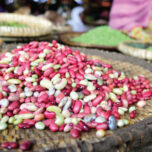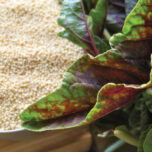September 6, 2019 — Imagine spending three weeks outside without water while temperatures regularly rise above 40 °C (104 °F). That’s a recipe for disaster for humans — and for most plants, too. But to many varieties of cowpea, it’s a mere hiccup on the way to producing high-protein, nutritious beans that have cultural significance around the world.
Ousmane Boukar, a cowpea breeder at the International Institute of Tropical Agriculture in Nigeria, is working to understand how cowpeas withstand such brutal droughts. That’s important because regions of West Africa, where Boukar says that most people eat cowpea practically every day, are expected to get drier and hotter with climate change. For food security and economic stability, growers will need varieties that can withstand those changes.
Along with other scientists, Boukar is using emerging information about cowpea genetics to better understand how the crop responds to drought — and how we might make it even more tolerant. While cowpeas have a reputation for tolerating drought, individual varieties differ greatly. If researchers find that varieties that thrive under dry conditions all have the same mutation in one gene, they can investigate that gene to learn how — or if — it affects drought tolerance, then breed it into other varieties to make them more tolerant, too.

International Institute of Tropical Agriculture researcher Ousmane Boukar (left) and a colleague screen cowpeas for drought resistance. Photo courtesy of Ousmane Boukar
Ira Herniter, a Ph.D. student at the University of California, Riverside, is one of those other scientists investigating the genetics of cowpea. He’s using similarities and differences in the genetic makeup of plants in addition to archaeological evidence and old texts from around the world to piece together the history of the crop’s diverse varieties and their dispersal around the globe. He and his advisor, UC-Riverside plant geneticist Timothy Close, say that understanding this history is important for protecting the diversity of the cowpea today and for improving our ability to breed varieties well-suited to specific conditions in the future.
Herniter says that domesticated cowpeas spread from West Africa to East Africa. These East African domesticated varieties were taken to South Africa where they interbred with that region’s native cowpeas. They were transported up the Nile River into Egypt by about 2500 BC and, from there, into the Mediterranean Basin. And they were taken east to Arabia, where tradespeople carried them to India. From India, they spread east to China, where selective breeding led to bean pods 50–90 centimeters (2–3 feet) long.
Cowpeas came to the Americas more recently, in the 16th or 17th centuries AD, where indigenous peoples quickly incorporated them as a staple food. In the U.S. today, a type of cowpea called black-eyed pea is both a valuable source of protein and a cultural icon.
Cowpea production has declined in the U.S. in recent decades. But with drought caused by climate change and depleted aquifers leaving farmlands in regions of India, the U.S., Africa and elsewhere high and dry, Close thinks the time is right to bring cowpeas back in vogue — and he’s doing his part.
He recently helped sequence the cowpea genome, making it easier for researchers to determine the genetic underpinnings of specific traits, including drought tolerance. For instance, Boukar’s team screened over 1,000 cowpea lines to identify those with the highest drought tolerance. They selected the 10 varieties that performed best for further breeding. The genome sequence of cowpea could make it easier for Boukar’s team to figure out which genes — or combinations of genes — in those 10 varieties contribute to drought tolerance, helping breeders maximize the number of genes for drought tolerance in new varieties.
Herniter says that because less research has been done on cowpeas than on crops like rice and soybean, “many of the large leaps” in breeding have not yet been taken. That means potentially more bang for the research buck in terms of advancing crop productivity and food security.
With the genome now sequenced, we might be hearing lots more about not only cowpea’s past but also its future in the months and years ahead.
Editor’s note: Becky Mackelprang wrote this story while serving as a AAAS Mass Media Science and Engineering Fellow with Ensia.
Related Posts
Ensia shares solutions-focused stories free of charge through our online magazine and partner media. That means audiences around the world have ready access to stories that can — and do — help them shape a better future. If you value our work, please show your support today.
Yes, I'll support Ensia!





